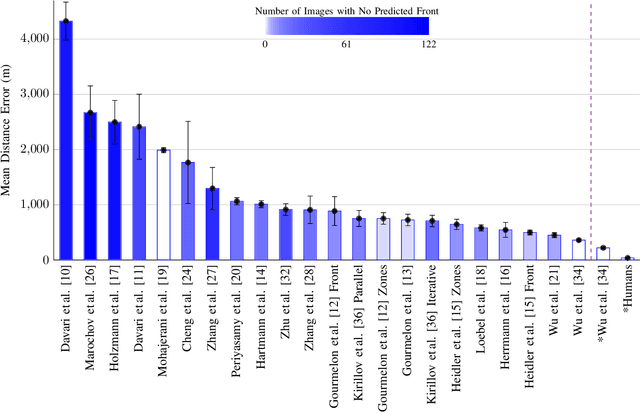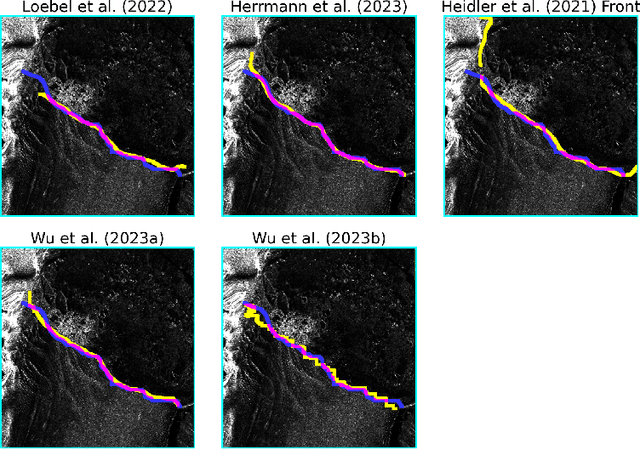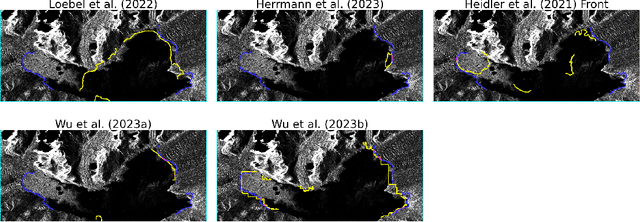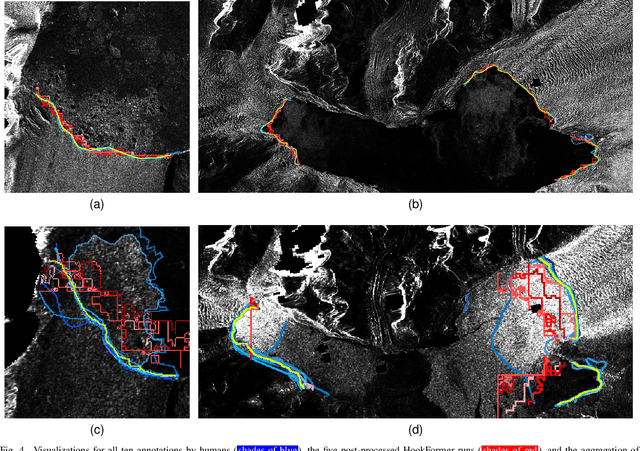Vincent Christlein
Pattern Recognition Lab, FAU Erlangen-Nürnberg
Data Augmentation via Latent Diffusion Models for Detecting Smell-Related Objects in Historical Artworks
Sep 18, 2025Abstract:Finding smell references in historic artworks is a challenging problem. Beyond artwork-specific challenges such as stylistic variations, their recognition demands exceptionally detailed annotation classes, resulting in annotation sparsity and extreme class imbalance. In this work, we explore the potential of synthetic data generation to alleviate these issues and enable accurate detection of smell-related objects. We evaluate several diffusion-based augmentation strategies and demonstrate that incorporating synthetic data into model training can improve detection performance. Our findings suggest that leveraging the large-scale pretraining of diffusion models offers a promising approach for improving detection accuracy, particularly in niche applications where annotations are scarce and costly to obtain. Furthermore, the proposed approach proves to be effective even with relatively small amounts of data, and scaling it up provides high potential for further enhancements.
SSL4SAR: Self-Supervised Learning for Glacier Calving Front Extraction from SAR Imagery
Jul 02, 2025Abstract:Glaciers are losing ice mass at unprecedented rates, increasing the need for accurate, year-round monitoring to understand frontal ablation, particularly the factors driving the calving process. Deep learning models can extract calving front positions from Synthetic Aperture Radar imagery to track seasonal ice losses at the calving fronts of marine- and lake-terminating glaciers. The current state-of-the-art model relies on ImageNet-pretrained weights. However, they are suboptimal due to the domain shift between the natural images in ImageNet and the specialized characteristics of remote sensing imagery, in particular for Synthetic Aperture Radar imagery. To address this challenge, we propose two novel self-supervised multimodal pretraining techniques that leverage SSL4SAR, a new unlabeled dataset comprising 9,563 Sentinel-1 and 14 Sentinel-2 images of Arctic glaciers, with one optical image per glacier in the dataset. Additionally, we introduce a novel hybrid model architecture that combines a Swin Transformer encoder with a residual Convolutional Neural Network (CNN) decoder. When pretrained on SSL4SAR, this model achieves a mean distance error of 293 m on the "CAlving Fronts and where to Find thEm" (CaFFe) benchmark dataset, outperforming the prior best model by 67 m. Evaluating an ensemble of the proposed model on a multi-annotator study of the benchmark dataset reveals a mean distance error of 75 m, approaching the human performance of 38 m. This advancement enables precise monitoring of seasonal changes in glacier calving fronts.
Comparison Study: Glacier Calving Front Delineation in Synthetic Aperture Radar Images With Deep Learning
Jan 09, 2025



Abstract:Calving front position variation of marine-terminating glaciers is an indicator of ice mass loss and a crucial parameter in numerical glacier models. Deep Learning (DL) systems can automatically extract this position from Synthetic Aperture Radar (SAR) imagery, enabling continuous, weather- and illumination-independent, large-scale monitoring. This study presents the first comparison of DL systems on a common calving front benchmark dataset. A multi-annotator study with ten annotators is performed to contrast the best-performing DL system against human performance. The best DL model's outputs deviate 221 m on average, while the average deviation of the human annotators is 38 m. This significant difference shows that current DL systems do not yet match human performance and that further research is needed to enable fully automated monitoring of glacier calving fronts. The study of Vision Transformers, foundation models, and the inclusion and processing strategy of more information are identified as avenues for future research.
Gesture Classification in Artworks Using Contextual Image Features
Dec 04, 2024



Abstract:Recognizing gestures in artworks can add a valuable dimension to art understanding and help to acknowledge the role of the sense of smell in cultural heritage. We propose a method to recognize smell gestures in historical artworks. We show that combining local features with global image context improves classification performance notably on different backbones.
Nuremberg Letterbooks: A Multi-Transcriptional Dataset of Early 15th Century Manuscripts for Document Analysis
Nov 11, 2024



Abstract:Most datasets in the field of document analysis utilize highly standardized labels, which, while simplifying specific tasks, often produce outputs that are not directly applicable to humanities research. In contrast, the Nuremberg Letterbooks dataset, which comprises historical documents from the early 15th century, addresses this gap by providing multiple types of transcriptions and accompanying metadata. This approach allows for developing methods that are more closely aligned with the needs of the humanities. The dataset includes 4 books containing 1711 labeled pages written by 10 scribes. Three types of transcriptions are provided for handwritten text recognition: Basic, diplomatic, and regularized. For the latter two, versions with and without expanded abbreviations are also available. A combination of letter ID and writer ID supports writer identification due to changing writers within pages. In the technical validation, we established baselines for various tasks, demonstrating data consistency and providing benchmarks for future research to build upon.
Zero-Shot Paragraph-level Handwriting Imitation with Latent Diffusion Models
Sep 01, 2024



Abstract:The imitation of cursive handwriting is mainly limited to generating handwritten words or lines. Multiple synthetic outputs must be stitched together to create paragraphs or whole pages, whereby consistency and layout information are lost. To close this gap, we propose a method for imitating handwriting at the paragraph level that also works for unseen writing styles. Therefore, we introduce a modified latent diffusion model that enriches the encoder-decoder mechanism with specialized loss functions that explicitly preserve the style and content. We enhance the attention mechanism of the diffusion model with adaptive 2D positional encoding and the conditioning mechanism to work with two modalities simultaneously: a style image and the target text. This significantly improves the realism of the generated handwriting. Our approach sets a new benchmark in our comprehensive evaluation. It outperforms all existing imitation methods at both line and paragraph levels, considering combined style and content preservation.
Novel Artistic Scene-Centric Datasets for Effective Transfer Learning in Fragrant Spaces
Jul 16, 2024



Abstract:Olfaction, often overlooked in cultural heritage studies, holds profound significance in shaping human experiences and identities. Examining historical depictions of olfactory scenes can offer valuable insights into the role of smells in history. We show that a transfer-learning approach using weakly labeled training data can remarkably improve the classification of fragrant spaces and, more generally, artistic scene depictions. We fine-tune Places365-pre-trained models by querying two cultural heritage data sources and using the search terms as supervision signal. The models are evaluated on two manually corrected test splits. This work lays a foundation for further exploration of fragrant spaces recognition and artistic scene classification. All images and labels are released as the ArtPlaces dataset at https://zenodo.org/doi/10.5281/zenodo.11584328.
Smell and Emotion: Recognising emotions in smell-related artworks
Jul 05, 2024



Abstract:Emotions and smell are underrepresented in digital art history. In this exploratory work, we show that recognising emotions from smell-related artworks is technically feasible but has room for improvement. Using style transfer and hyperparameter optimization we achieve a minor performance boost and open up the field for future extensions.
Offline Writer Identification Using Convolutional Neural Network Activation Features
Feb 26, 2024Abstract:Convolutional neural networks (CNNs) have recently become the state-of-the-art tool for large-scale image classification. In this work we propose the use of activation features from CNNs as local descriptors for writer identification. A global descriptor is then formed by means of GMM supervector encoding, which is further improved by normalization with the KL-Kernel. We evaluate our method on two publicly available datasets: the ICDAR 2013 benchmark database and the CVL dataset. While we perform comparably to the state of the art on CVL, our proposed method yields about 0.21 absolute improvement in terms of mAP on the challenging bilingual ICDAR dataset.
* fixed tab 1b
ARIN: Adaptive Resampling and Instance Normalization for Robust Blind Inpainting of Dunhuang Cave Paintings
Feb 25, 2024Abstract:Image enhancement algorithms are very useful for real world computer vision tasks where image resolution is often physically limited by the sensor size. While state-of-the-art deep neural networks show impressive results for image enhancement, they often struggle to enhance real-world images. In this work, we tackle a real-world setting: inpainting of images from Dunhuang caves. The Dunhuang dataset consists of murals, half of which suffer from corrosion and aging. These murals feature a range of rich content, such as Buddha statues, bodhisattvas, sponsors, architecture, dance, music, and decorative patterns designed by different artists spanning ten centuries, which makes manual restoration challenging. We modify two different existing methods (CAR, HINet) that are based upon state-of-the-art (SOTA) super resolution and deblurring networks. We show that those can successfully inpaint and enhance these deteriorated cave paintings. We further show that a novel combination of CAR and HINet, resulting in our proposed inpainting network (ARIN), is very robust to external noise, especially Gaussian noise. To this end, we present a quantitative and qualitative comparison of our proposed approach with existing SOTA networks and winners of the Dunhuang challenge. One of the proposed methods HINet) represents the new state of the art and outperforms the 1st place of the Dunhuang Challenge, while our combination ARIN, which is robust to noise, is comparable to the 1st place. We also present and discuss qualitative results showing the impact of our method for inpainting on Dunhuang cave images.
 Add to Chrome
Add to Chrome Add to Firefox
Add to Firefox Add to Edge
Add to Edge